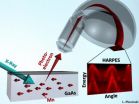(Press-News.org) MADISON – A new study shows that a blood marker is linked to pancreatic cancer, according to a study published today by scientists at the University of Wisconsin Carbone Cancer Center and Mayo Clinic.
First author Dr. Halcyon Skinner, assistant professor of population health sciences at the University of Wisconsin School of Medicine and Public Health, says the study is the first time pancreatic cancer risk has been linked to differences in telomeres' length in blood cells.
"This suggests a new avenue to identify those with pancreatic cancer or those at risk of developing the cancer in the future,'' he says.
Skinner's colleagues at Mayo Clinic took blood samples from more than 1,500 people – 499 of them with a diagnosis of pancreatic cancer and 963 of them cancer-free control subjects. Specifically, the scientists were interested in the length of the telomeres – the end caps on chromosomes – found in white blood cells. They found a direct relationship with the risk of pancreatic cancer: the shorter the telomeres, the more likely a person was to have pancreatic cancer.
Telomeres maintain the stability of genes, and are known to shorten with age as cells divide. People of the same chronological age can have vastly different telomere lengths. In other words, some people's cells can by viewed as biologically older than cells from other people the same age.
"We know that people with many factors that are classically unhealthy also tend to have shorter telomeres. Those who have had stressful lives, exposed to chronic inflammation, have poor glucose control or smoked cigarettes tend to have shorter telomeres, and that can set the stage for genetic damage,'' Skinner explains.
Shortened telomeres in the blood have already been associated with other types of cancer, including colon cancer.
"We found the same relationship with pancreatic cancer, and for the vast majority of our participants, there was a direct linear relationship," he says, "the shorter the telomere, the higher the likelihood of pancreatic cancer."
But because shorter telomere length is also associated with the development of other cancers and other diseases of aging, measurement of telomere length alone is not a specific marker for pancreatic cancer.
Dr. Lisa A. Boardman, of Mayo Clinic, who led the overall study, says that future studies need to address if telomere length and other markers of pancreatic cancer should be combined to create a test that could be used clinically.
###
Skinner and UW colleagues Ron Gangnon and Kristin Litzelman led the design and data analysis of the study. It is being published in Cancer Epidemiology, Biomarkers and Prevention, a journal of the American Association for Cancer Research.
Skinner's work was supported by the National Institutes of Health (K07 CA109361).
Blood chromosome differences are linked to pancreatic cancer
2012-10-24
ELSE PRESS RELEASES FROM THIS DATE:
Genetic patterns of deep-sea coral provide insights into evolution of marine life
2012-10-24
The ability of deep-sea corals to harbor a broad array of marine life, including commercially important fish species, make these habitat-forming organisms of immediate interest to conservationists, managers, and scientists. Understanding and protecting corals requires knowledge of the historical processes that have shaped their biodiversity and biogeography.
While little is known about these processes, new research described in the journal Molecular Ecology helps elucidate the historical patterns of deep-sea coral migration and gene flow, coincident with oceanic circulation ...
New finding could pave way to faster, smaller electronics
2012-10-24
University of California, Davis, researchers for the first time have looked inside gallium manganese arsenide, a type of material known as a "dilute magnetic semiconductor" that could open up an entirely new class of faster, smaller devices based on an emerging field known as "spintronics."
Materials of this type might be used to read and write digital information not by using the electron's charge, as is the case with today's electronic devices, but by using its "spin."
Understanding the magnetic behavior of atoms is key to designing spintronics materials that could ...
New paper examines shifting gears in the circadian clock of the heart
2012-10-24
A new study conducted by a team of scientists led by Giles Duffield, assistant professor of biological sciences and a member of the Eck Institute for Global Health at the University of Notre Dame focuses on the circadian clock of the heart, and used cultured heart tissue. The results of the new study have implications for cardiovascular health, including daily changes in responses to stress and the effect of long-term rotational shift work.
Previous studies by a research group at the University of Geneva demonstrated a role for glucocorticoids in shifting the biological ...
Droplet response to electric voltage in solids exposed
2012-10-24
DURHAM, N.C. – For the first time, scientists have observed how droplets within solids deform and burst under high electric voltages.
This is important, the Duke University engineers who made the observations said, because it explains a major reason why such materials as insulation for electrical power lines eventually fail and cause blackouts. This observation not only helps scientists develop better insulation materials, but could also lead to such positive developments as "tunable" lenses for eyes.
As the voltage increases, water droplets, or air bubbles, within ...
Analysis of dinosaur bone cells confirms ancient protein preservation
2012-10-24
A team of researchers from North Carolina State University and the Palo Alto Research Center (PARC) has found more evidence for the preservation of ancient dinosaur proteins, including reactivity to antibodies that target specific proteins normally found in bone cells of vertebrates. These results further rule out sample contamination, and help solidify the case for preservation of cells – and possibly DNA – in ancient remains.
Dr. Mary Schweitzer, professor of marine, earth and atmospheric sciences with a joint appointment at the North Carolina Museum of Natural Sciences, ...
NJIT math professor calls Detroit Tigers a favorite to win World Series
2012-10-24
Since the Major League Baseball Division Series and League Championship Series have determined which teams will compete in the World Series, NJIT Math Professor Bruce Bukiet has again analyzed the probability of each team taking the title.
"The Detroit Tigers have a solid advantage over the San Francisco Giants. The Tigers, who surprisingly swept the New York Yankees in four straight games in the American League Championship Series to reach the World Series, have a 58 percent chance of beating the Giants in the best of seven series," he said.
At the season's start, ...
Medical recommendations should go beyond race, scholar says
2012-10-24
EAST LANSING, Mich. — Medical organizations that make race-based recommendations are misleading some patients about health risks while reinforcing harmful notions about race, argues a Michigan State University professor in a new paper published in the journal Preventive Medicine.
While some racial groups are on average more prone to certain diseases than the general population, they contain "islands" of lower risk that medical professionals should acknowledge, said Sean Valles, assistant professor in MSU's Lyman Briggs College and the Department of Philosophy.
For instance, ...
New Jersey's teen driver decals linked with fewer crashes
2012-10-24
A new study from The Children's Hospital of Philadelphia (CHOP) provides initial evidence that New Jersey's Graduated Driver Licensing (GDL) decal requirement lowers crash rates among intermediate (i.e., probationary) teen drivers and supports the ability of police to enforce GDL provisions. The study, which linked New Jersey's licensing and crash record databases to measure effects of the requirement, was published today in the American Journal of Preventive Medicine. Crash involvement of an estimated 1,624 intermediate drivers was prevented in the first year after the ...
Leaner Navy looking at future technology, fleet size and sequestration
2012-10-24
ARLINGTON, Va.—Adm. Mark Ferguson, vice chief of naval operations, headlined the opening of the ONR (Office of Naval Research) Naval S&T (science and technology) Partnership Conference and ASNE Expo Oct. 22, 2012, and highlighted the importance of innovative S&T programs being developed by the Navy. He also offered a revealing look at the potential future for the Navy if sequestration, or automatic defense cuts, goes into effect in January.
Speaking to a capacity crowd as keynote speaker, Ferguson said the Navy is already working hard to do more across the globe—with ...
Local wildlife is important in human diets
2012-10-24
Animals like antelope, frogs and rodents may be tricky to catch, but they provide protein in places where traditional livestock are scarce. According to the authors of a new paper in Animal Frontiers, meat from wild animals is increasingly important in central Africa.
"The elephant or hippopotamus may provide food for an entire community, smaller antelope may feed a family, while a rat or lizard may quell the hunger of an individual. Alternatively, these species are often sold on the road side or at local markets to supply a much needed source of cash revenue," write ...




